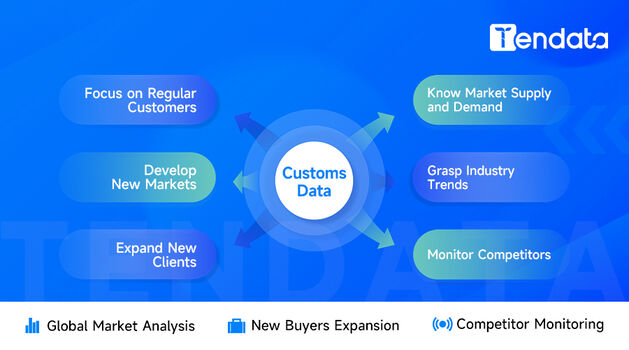 Export News
Export News
 2024-02-18
2024-02-18
Typically, exporters already know what they want to export. However, in certain situations, exporters may be seeking potential industries, products, or services to promote their business growth.
There are two methods to achieve this:
The first method is to passively wait for potential new customers to contact you, inquire about your products or services, and hope for future orders. Platforms like Alibaba International Station, independent websites, etc., are examples of passive waiting for customers to come to you.
The second method to increase exports is to identify strategic buyers for your products or services, identify segmented markets that use your goods, countries with a demand for the products you sell, and global companies you will compete with. Then, through proactive marketing, recommend your products to potential customers. Although this strategy requires more effort, it has the potential to bring significant and sustained growth, helping your company elevate revenue and profits to a new level.

Tendata facilitates this for exporters through customs data. Customs data refers to information related to imported and exported goods obtained from customs, including product names, quantities, values, importer/exporter information, etc. In comparison to costly offline exhibitions, SEO, SEM, and other methods, customs data offers advantages such as:
1. Market Understanding and Positioning: Customs data helps exporters gain in-depth insights into international markets, analyzing import and export situations in different countries and regions. This assists exporters in identifying the most promising markets and developing corresponding positioning and strategies.
2. Target Customer Identification: By analyzing customs data, exporters can identify potential target customers. Understanding the import and export situation of specific products or industries helps exporters find potential buyers or suppliers and enables precise market positioning.
3. Competitor Analysis: By studying competitors' customs data, exporters can comprehend the competitive environment, analyze competitors' market share, import/export strategies, and pricing strategies, allowing for the formulation of more effective competitive strategies.
4. Market Trend Forecasting: Through long-term analysis of customs data, exporters can identify market trends and make corresponding strategic adjustments. This helps exporters better adapt to market changes and maintain a competitive advantage.
Tendata helps you identify business opportunities! Tendata assists in recognizing strategic markets, countries, and competitors, as well as providing effective background checks for each company, so you know where to focus on customer development.
"Customs data contains vast information, and extracting relevant customer contact details can be time-consuming, often yielding results that fall short of expectations. Is it really the case? Or is it because customs data is being utilized incorrectly, resulting in wasted effort and time?
Developing customers using customs data involves precisely characterizing all buyers and their procurement systems in the target market. This allows for the quick identification of the most compatible customers, discerning their credit systems and procurement details. It aids in defining high-quality customers and profit margins, enhancing development efficiency, and improving overall effectiveness. When using customs data to develop new customers, consider the following three approaches. (>>>Click to Get Free Access to Customs Data for 90+ Countries)

I. Establish Customer Resource Database by Country
The establishment of a customer resource database is akin to a personalized work record. Start by using trade tracking functionality to compile a list of all customers in a country. Then, analyze each buyer's purchase volume, procurement cycle, product specifications, and supplier system. Pay special attention to the diversification or singularity of a buyer's supply channels, as buyers with diverse supply sources are preferable. Finally, filter out 30% of the potentially high-quality customers from that country and record them in your customer resource database. The database can be flexibly organized by country, time, customer name, follow-up steps, contact phone, email, contact person, etc. (>>>Click to Develop New Customers)
II. Establish Customer Resource Database by Peer Companies
Have a good understanding of the English names (including full names, abbreviations, etc.) of peer companies. Utilize the global supplier networking feature to compile a list of all customers associated with these peer companies. The critical step is to analyze customers from these peer companies based on purchase volume, procurement cycle, product models, etc. Finally, filter out key customers from your identified peers and record them in your customer resource database. (>>>Click to Apply for Free Trial)
III. Identify Newly Appeared Customers in Each Country
Use the trade search function to identify customers newly appeared in a country. Choose the country, set the date range, limit the product name or customs code, and check the "Newest" option. The search results will display high-quality customers that have newly emerged in that country within the specified time frame. Since these customers are new, they may have just started transactions, and the stability of their suppliers may be uncertain. It's essential to focus on following up with these new potential buyers and record them in your customer resource database. (>>>Click to Apply for Free Trial)
These three approaches for developing customers using customs data can be implemented based on the actual needs of the company and oneself. Consider the market environment, industry characteristics, strategic requirements, etc., to find a suitable method. The ultimate goal is to establish and organize a categorized archive of high-quality customers. Once you identify suitable customers, the next step is to precisely contact them through various channels, such as phone calls, emails, and online communication.
Category
Leave Message for Demo Request or Questions


 T-info
T-info T-discovery
T-discovery

 My
Tendata
My
Tendata Market Analysis
Market Analysis Customer
Development
Customer
Development Competitor
Monitoring
Competitor
Monitoring Customer Relationship
Customer Relationship





































































































































